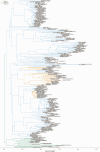Practical Guidance and Workflows for Identifying Fast Evolving Non-Coding Genomic Elements Using PhyloAcc
- PMID: 38816211
- PMCID: PMC11579529
- DOI: 10.1093/icb/icae056
Practical Guidance and Workflows for Identifying Fast Evolving Non-Coding Genomic Elements Using PhyloAcc
Abstract
Comparative genomics provides ample ways to study genome evolution and its relationship to phenotypic traits. By developing and testing alternate models of evolution throughout a phylogeny, one can estimate rates of molecular evolution along different lineages in a phylogeny and link these rates with observations in extant species, such as convergent phenotypes. Pipelines for such work can help identify when and where genomic changes may be associated with, or possibly influence, phenotypic traits. We recently developed a set of models called PhyloAcc, using a Bayesian framework to estimate rates of nucleotide substitution on different branches of a phylogenetic tree and evaluate their association with pre-defined or estimated phenotypic traits. PhyloAcc-ST and PhyloAcc-GT both allow users to define a priori a set of target lineages and then compare different models to identify loci accelerating in one or more target lineages. Whereas ST considers only one species tree across all input loci, GT considers alternate topologies for every locus. PhyloAcc-C simultaneously models molecular rates and rates of continuous trait evolution, allowing the user to ask whether the two are associated. Here, we describe these models and provide tips and workflows on how to prepare the input data and run PhyloAcc.
© The Author(s) 2024. Published by Oxford University Press on behalf of the Society for Integrative and Comparative Biology.
Conflict of interest statement
The authors declare no conflict of interest.
Figures



Similar articles
-
PhyloAcc-GT: A Bayesian Method for Inferring Patterns of Substitution Rate Shifts on Targeted Lineages Accounting for Gene Tree Discordance.Mol Biol Evol. 2023 Sep 1;40(9):msad195. doi: 10.1093/molbev/msad195. Mol Biol Evol. 2023. PMID: 37665177 Free PMC article.
-
Bayesian Detection of Convergent Rate Changes of Conserved Noncoding Elements on Phylogenetic Trees.Mol Biol Evol. 2019 May 1;36(5):1086-1100. doi: 10.1093/molbev/msz049. Mol Biol Evol. 2019. PMID: 30851112 Free PMC article.
-
A phylogenetic method linking nucleotide substitution rates to rates of continuous trait evolution.PLoS Comput Biol. 2024 Apr 24;20(4):e1011995. doi: 10.1371/journal.pcbi.1011995. eCollection 2024 Apr. PLoS Comput Biol. 2024. PMID: 38656999 Free PMC article.
-
Modeling Substitution Rate Evolution across Lineages and Relaxing the Molecular Clock.Genome Biol Evol. 2024 Sep 3;16(9):evae199. doi: 10.1093/gbe/evae199. Genome Biol Evol. 2024. PMID: 39332907 Free PMC article. Review.
-
A biologist's guide to Bayesian phylogenetic analysis.Nat Ecol Evol. 2017 Oct;1(10):1446-1454. doi: 10.1038/s41559-017-0280-x. Epub 2017 Sep 21. Nat Ecol Evol. 2017. PMID: 28983516 Free PMC article. Review.
Cited by
-
From Trees to Traits: A Review of Advances in PhyloG2P Methods and Future Directions.Genome Biol Evol. 2025 Sep 2;17(9):evaf150. doi: 10.1093/gbe/evaf150. Genome Biol Evol. 2025. PMID: 40907979 Free PMC article. Review.
-
Convergent evolution of noncoding elements associated with short tarsus length in birds.BMC Biol. 2025 Feb 21;23(1):52. doi: 10.1186/s12915-025-02156-4. BMC Biol. 2025. PMID: 39984930 Free PMC article.
References
-
- Adams DC, Collyer ML. 2019. Phylogenetic comparative methods and the evolution of multivariate phenotypes. Annu Rev Ecol Evol Syst. 50:405–25.
-
- Ane C, Larget B, Baum DA, Smith SD, Rokas A. 2006. Bayesian estimation of concordance among gene trees. Mol Biol Evol. 24:412–26. - PubMed
MeSH terms
Grants and funding
LinkOut - more resources
Full Text Sources
Miscellaneous

